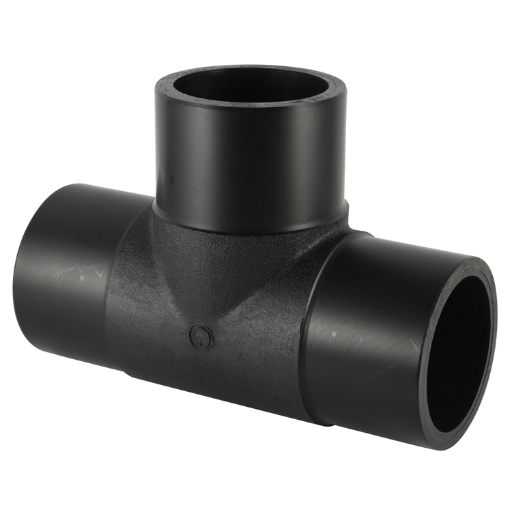HDPE (High-Density Polyethylene) has become the preferred choice among the available plastic pipe systems due to its strength, flexibility, and chemical resistance. HDPE butt fusion tee fitting is one of the most critical components in these systems, as it allows for the creation of junctions in pipelines. This blog seeks to give an all-rounded view of HDPE butt fusion tee fittings which includes: their designs, how they work, ways of installing them, and benefits that result from using them for various purposes. This article will provide valuable insights into how this type of fitting enhances the efficiency and reliability of HDPE piping systems. Either you are a professional in this field for many years or a beginner who wants to improve your knowledge.
What is a butt fusion tee?
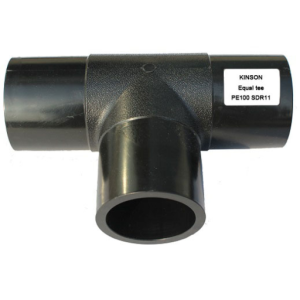
Image source: https://www.pe-fittings.com/
A butt fusion tee is a kind of connector used in HDPE piping systems designed to establish three-way connections between pipes, thus enabling efficient flow of fluids. It comprises two ends connecting the main pipes and a perpendicular outlet branching off. In the “butt fusion” process, both ends of pipes as well as the fitting’s ends, are heated until they melt, at which point they are pressed together, creating a solid, watertight connection. This technique increases the piping system’s integrity, resulting in more extended-lasting performance and dependability across numerous applications.
Understanding the basics of butt fusion
This method is commonly used for connecting HDPE pipes and fittings through butt fusion, giving a reliable continuous join. The process involves aligning the ends of the pipes and heating them until the surfaces melt, after which they are pressed together and allowed to cool down, forming a solid bond. In addition, this technique is preferred due to its ability to build joints that are stronger than the material of the pipe, which helps in minimizing leakages and failures. Moreover, it can be done on pipes of different sizes, making it efficient for small and large installations. Its merits include its economical, user-friendly nature and the construction of a sound piping system that can withstand harsh climatic conditions.
Structure and design of a tee
Tee fitting is one of the most essential parts of pipe systems, usually designed with three openings: one central line flow opening and another two branch angles at 90 degrees each. Consequently, this design allows fluids from one main pipe outlet into two separate lines to distribute effectively. Also, tees are made of various materials like PVC, metal, or HDPE, depending on their structure, hence compatible with diverse systems available in the market. They vary in applications needed; therefore, some may be heavily designed to withstand high pressure while others are just regular models for daily use. Good selection, as well as installation of such kind of fittings,,, therefore,, should be made correctly so as to maintain a good flow within pipelines without any pressure drop seen across it. Also known is that they come in different dimensions; hence, there can be flexibility on how they fit perfectly well with all projects’ specifications without any exceptions.
Applications of butt fusion tees
The reason why butt fusion tees are widely used in different industries is that they are capable of creating robust and no-leak connections in pipe systems. They serve as the link between primary and branch lines for smooth water distribution within the water and wastewater sector, such as potable water supply schemes and sewage networks. In the supply of gas industry, however, safety and reliability can only be assured by using gas fittings with butt fusion tees that can withstand high pressures without breaking these connections. Moreover, these fittings are often used to transport fluids such as chemicals in industrial applications without a leak-proof piping system. Butt fusion tees have become indispensable components for modern piping installations and maintenance processes because they are versatile enough to cater for various materials.
How do HDPE butt fusion tees work?
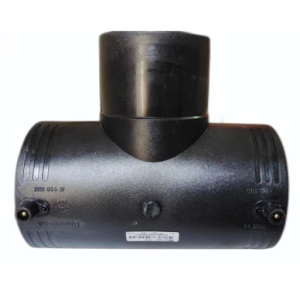
HDPE butt fusion tees perform their functions through an operation known as butt-fusion welding, whereby two HDPE pipes (a mainline pipe and a branch line) get heated and then joined together permanently so that they form a solid joint. At first, the ends of the pipes should meet before heat is applied to them by way of the heating element. Then, the heat source is removed when the material is melting, followed by pressing pipes together while allowing them to cool and harden. As a result, there is a bond between both parts, thereby making it possible to maintain its pressure ratings and integrity throughout existence, making it an excellent choice for any use that prioritizes lastingness plus leakage prevention.
Principle of butt fusion welding
Butt fusion welding is the art of making a solid joint between thermoplastics, mainly HDPE, coming together under high temperatures and pressures. The beginning of the process involves aligning and cleaning both ends of the pipe. Afterward, heating elements are utilized to increase the temperature at pipe ends, eventually melting. Then, these two surfaces are brought together to fuse softened substances when they cool and become hard again. When this technique is employed, no visible sign reveals a separate point where it has been welded. This method ensures that both areas in question are covered by identical material such that one cannot differentiate them from each other.
Benefits of using HDPE
HDPE, short for High-Density Polyethylene, boasts numerous benefits, making it highly preferred in various applications. Its outstanding strength, which can withstand tensile forces and resistance to impact, makes it durable and fit for high-pressure environments like water pipes or chemical stores. Secondly, HDPE does not corrode or succumb to environmental stress; thus, its longevity in comparison with conventional materials like metal or concrete is preserved. Thirdly, installation processes have been simplified since they are lightweight and easy to move around. Moreover, recycling HDPE helps minimize waste, leading to sustainable practices to achieve circular economy goals. Finally, through low moisture absorption and UV resistance, it enhances its performance in different climatic conditions, guaranteeing reliability whether indoors or outdoors.
Steps to Install HDPE Butt Fusion Tees
- Preparation: Clean all welded surfaces of contaminants. Use a cloth and appropriate solvent to remove dust or oil.
- Cutting: Use a pipe cutter to obtain straight, square cuts on the tee and the pipe. This is necessary for well-matched jointing and effective fusion.
- Alignment: Position the HDPE tee and the pipe correctly in the fusion machine. The ends should meet gently without applying too much force so that they can be aligned for accurate welding.
- Heating: Set the temperature of the heating element (usually 200-220°C or 392-428°F). Heat the machine until you can bring the pipe against this heating plate with a tee to melt their interfaces for the specified time.
- Joining: After this time, rapidly remove the heating plate and use regulated compression as stipulated by the manufacturer to make connections between these two members.
- Cooling: Avoid moving joint areas until the cooling period for a reliable bond has lapsed. Finally, check for faulty joints or inclusions.
- Testing: Essential pressure tests are conducted after closing the joints to ascertain whether the fusion was successful. This ensures everything works fine before this system commences its normal operation mode.
If you follow these steps, your HDPE Butt Fusion Tees will create strong connections that last long.
What are the specifications for butt fusion tee fittings?
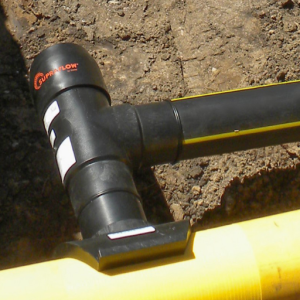
Specifically, the designed dimensions and material properties of butt fusion tee fittings ensure compatibility and performance in various applications. Some of the key specifications include:
- Materials: Usually made of High-Density Polyethylene (HDPE) due to its high chemical resistance and durability.
- Size Range: It comes in different sizes, usually starting from 1 inch and going up to about twenty-four inches in diameter, which allows for various pipeline configurations.
- Pressure Rating: It is commonly rated under different pressure classes, such as SDR 11, SDR 17, etc., indicating its suitability for different pressure applications.
- Joint Type: Fit for butt fusion welding that gives a seamless connection hence enhancing the structural integrity of the pipeline.
- Temperature Resistance: They are suitable for use within a wide temperature range, generally ranging from -40°F to 180°F, depending on specific grades or environmental conditions.
These specifications make sure that butt fusion tee fittings effectively meet the needs of both indoor and outdoor plumbing systems.
Typical sizes like 4in and dimensions
Butt Fusion Tee fittings come in various sizes to fit different piping systems. The usual sizes include:
- 2 inches (50 mm): Often used for smaller applications and residential plumbing.
- 4 inches (100 mm): Frequently utilized in industrial settings for moderate flow control.
- 6 inches (150 mm): Standard for municipal water supply and larger residential projects.
- 8 inches (200 mm) and above: Utilised in heavy-duty industrial and commercial systems.
The dimensions of these fittings vary according to the wall thickness required for pressure ratings, with typical PVC or HDPE wall thicknesses being about 0.5mm-10mm, depending on size and application. For particular projects, it is important to consult manufacturer specifications to verify that they match existing system requirements and adhere to local codes.
Understanding SDR and SDR 11
SDR or Standard Dimension Ratio refers to a pipe’s diameter ratio to its wall thickness. It is an essential factor in determining the strength and pressure ratings of pipes. It means that for SDR 11, ID = 11 times WT. For instance, SDR 11 pipes are made to withstand higher pressures; hence, they are applicable in various sectors like water distribution and industries because they have these qualities which make them more suitable. Thus, while choosing fittings and pipes, it is vital to consider the manufacturer’s specifications as this will help ensure that there is the correct choice of SDR depending on the applicability of the specific pressure and environmental conditions.
Materials and Mold Details
The materials used in making fittings and pipes greatly influence their durability as well as performance. Some of the commonly employed materials include PVC (polyvinyl chloride), HDPE (High-density polyethylene), and CPVC (chlorinated polyvinyl chloride), all of which have distinct strengths. Residents prefer PVC for plumbing work since it is lightweight, cheap, and does not rust or get damaged by chemicals, thus extending its life span. On the other hand, HDPE has excellent tensile strength and flexibility, making it ideal for situations where impact resistance and UV exposure are needed, such as underground applications, especially those involving buried electrical cables or telecom ducting systems. Lastly, CPVC can be used in hot water applications because it has a higher temperature tolerance than PVC.
The quality of molds used in producing these pipes and fittings is crucial for ensuring dimensional accuracy and consistency regarding mold details. Mold designs must be meticulously maintained to resist the molding process pressures and the working environment where materials will operate. Depending on the design requirements and applications, injection molding or blow molding can be employed using advanced methods. Proper mold design considers wall thickness, draft angles, and surface finish that help improve efficiency and product life.
How to Maintain Butt Fusion Tee Fittings?
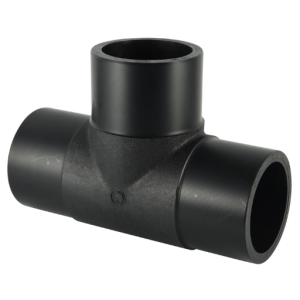
To maintain butt fusion tee fittings, proper care, and regular inspection are required to ensure their functionality. The following recommendations can be helpful:
- Periodic Inspections: Regularly inspect the fittings for wear, damage, or leakage problems. Look out for cracks, any visible separations in joints, and deformations.
- Cleanliness: Ensure cleanliness around fittings and fittings themselves. Remove all litter that may compromise joint integrity or affect fitting performance.
- Avoid Overloading: Tightening connections too much should be avoided so the piping system does not pull at the joints.
- Temperature Monitoring: Consider temperature levels so you do not expose your fitting materials to extreme temperatures.
- Professional Evaluation: When issues are noticed, one should consider engaging a certified technical person to examine them to establish whether repairs or replacements are necessary to maintain system efficiency.
By doing this, you will extend the service life of your pipe system’s butt fusion tee fittings.
Inspection and handling of pipeline fittings
When checking pipeline fittings, following industry standards for safety and performance is crucial. The following are the most important steps:
- Visual Inspection: Examine visually to detect cracks, corrosion, or other damage signs. Confirm correct alignment and security of all fittings.
- Testing for Leaks: Pressure tests or leak detection techniques can be used to ascertain if the fittings have been installed correctly. This will enable the identification of any probable leaks that would jeopardize the system.
- Documentation: Maintain accurate records of inspections carried out and any maintenance done over time. This helps trace the condition of fittings over time and also aids in planning for future maintenance requirements.
- Safe Handling Procedures: While installing or maintaining them, follow safety protocols such as using proper lifting methods and not forgetting to wear appropriate PPE (personal protective equipment), which prevents injury and damage to components.
- Compliance with Standards: Materials and fittings must adhere to safety regulations set up by governments and industries according to application and location-based specifics; therefore, material selection should consider this aspect.
These inspection practices must be followed for pipe fittings to last longer and work efficiently.
Common issues and their fixes
Several common issues may arise when working with butt fusion tee fittings, along with how to solve them effectively:
- Misalignment during Installation: Misalignment can lead to weak connections and possible leakage. To fix the misalignment problem, ensure installation surfaces are clean and use proper alignment tools while fusing to keep the fitting straight.
- Insufficient Heating: Joint strength can be compromised if there is overheating or underheating during the fusion process. To avoid this challenge, always adhere to heating equipment calibration requirements given by manufacturers so that you can achieve the desired results.
- Inadequate Cooling Time: If the cooling phase is done hurriedly, it may have a weak bond. The industry standard cooling time, which usually lasts between 20 and 30 minutes, should be observed before putting the back system into operation for full joint strength.
- Contamination of the Fusion Surface: Dirt, grease, or moisture on the surface will impede fusion and cause failure. Use the appropriate solvents on these surfaces before fusing, and also ensure they are dry enough to enhance good bonding.
The identification and resolution of these common challenges, therefore, improve the reliability of butt fusion tee fittings hence efficiency in the piping system.
Best practices for long-term performance
- Regular Inspection: Inspect the pipes to identify wear, leaks, or misalignments. This will prevent major problems later.
- Proper Storage: Fittings must be stored in a dark, dry place that is not affected by high temperatures. This will preserve their original state and characteristics up to the moment of installation.
- Adhere to Manufacturer Guidelines: Always follow the manufacturers’ instructions for set-up and operation. This includes temperature and pressure specifications, as well as maintenance recommendations.
- Education and Training: All installation/maintenance team members should know butt fusion techniques and standards. They should also understand how to keep equipment clean and operate it properly.
- Use Quality Materials: For lastingness and performance enhancement, choose better-quality fittings and accessories made by reputable manufacturers. Avoid using low-priced components, which may undermine the integrity of your system.
Adhering to these guidelines could improve the lifetime use of buttfusion tees, which have been used for many years, thereby making pipelines work reliably throughout this duration.
Reference sources
-
HDPE Butt Fusion Tees – HDPE Supply
This source provides a comprehensive overview of HDPE butt fusion tees, detailing product specifications, applications, and the fusion process. The site offers detailed descriptions of various fittings, ensuring that users understand the different types and their uses. It is beneficial for professionals seeking reliable and detailed technical information.
Read more -
HDPE Butt Fusion Tees | Fabricated and Molded Elbows – ISCO
ISCO’s page on HDPE butt fusion tees covers both molded and fabricated options. The content includes information on these fittings’ production standards, testing, and quality assurance. The site also provides insights into the applications and benefits of using HDPE fittings in various industries.
Read more -
HDPE Molded Butt Fusion Tee – Bingo Pipes
Bingo Pipes offers a detailed look at the HDPE molded butt fusion tee, including its features, applications, and advantages. The site emphasizes using these fittings in sectors like drinking water, drainage, and industrial applications. It also highlights the environmental benefits of using HDPE materials.
Read more
Related Articles: About Butt Fusion Tee Application Areas



